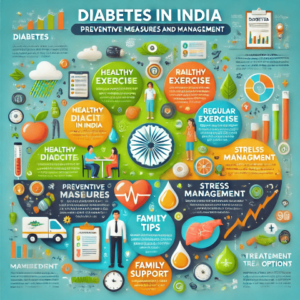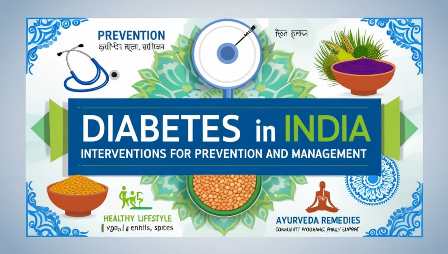Diabetes in India, which affects millions of people in urban and rural areas, is rapidly becoming a serious public health concern in the country. Changes in lifestyle, greater awareness, and the implementation of suitable therapies are all necessary components for the successful prevention and management of diabetes.
Presented in a manner that is approachable and conversational, this blog digs into the rising incidence of diabetes in India, as well as strategies for preventing the disease and methods for managing it.
Understanding the effects of diabetes is crucial.
Diabetes, a persistent condition, causes the body to lose control of blood sugar.
There are three types of diabetes: Type one, Type two, and Gestational diabetes.
Type 2 diabetes is the most common form of the disease in India. Statistics from recent years indicate that India is the country with the highest number of diabetics in the world, with over 77 million people living with the condition.
Urbanization, sedentary lifestyles, and poor eating habits are just a few of the factors contributing to this worrying trend.
It is possible to combat this sickness by first gaining an understanding of the reasons, taking preventative measures, and then implementing suitable diabetes control practices.

Here’s important data related to diabetes in India, presented in tabular form:
| Aspect | Data/Details |
|---|---|
| Prevalence of Diabetes in India (2024) | 77 million adults affected (projected to reach 134 million by 2045) |
| Type of Diabetes Cases | 90%-95% Type 2 Diabetes, ~5%-10% Type 1 Diabetes |
| Age Group Most Affected | 40–59 years |
| Urban vs Rural Prevalence | Urban: ~12-14%, Rural: ~6-8% |
| Top Risk Factors | Sedentary lifestyle, unhealthy diet, obesity, family history |
| Annual Diabetes-related Deaths | Over 1 million |
| Economic Burden (Estimated) | $9 billion annually |
| Common Complications | Cardiovascular diseases, neuropathy, retinopathy, kidney failure |
| Ayurvedic Remedies | Bitter gourd (Karela), Fenugreek (Methi), Indian Gooseberry (Amla) |
| Government Initiatives | National Programme for Prevention and Control of Cancer, Diabetes, CVD, Stroke |
| Recommended Exercise Duration | 150 minutes of moderate aerobic activity per week |
| Diabetes-friendly Foods | Whole grains, lentils, leafy vegetables, nuts, seeds |
| Awareness Programs | Diabetes Walkathons, World Diabetes Day Campaigns, Rural Outreach Camps |
| Impact of Urbanization | Higher prevalence due to fast food, reduced physical activity, pollution |
| Best Hospitals for Treatment | AIIMS (Delhi), Apollo Hospitals, Narayana Health |
This table provides a concise summary of the critical statistics and measures for better understanding and action.
Why are there more people reported to have diabetes in India?
A variety of different conditions are to blame for the increase in diabetes diagnoses in India.
Rapid urbanization has resulted in more sedentary lifestyles, increased screen time, and decreased levels of physical activity. Numerous Indians have experienced a significant improvement in their health as a result of this shift.
Diets that are unhealthy: The problem has been made worse by the growing consumption of processed foods, beverages that are high in sugar, and meals that are high in calories. Indians have a hereditary predisposition to insulin resistance, which makes them more likely to develop diabetes.
One of the most important factors in the development of diabetes in India is stress—specifically modern-day stress and a lack of proper stress management for diabetes prevention.
Strategies for Diabetes Prevention and Management
Prevention is always preferable to treatment in any situation. Taking steps to improve one’s lifestyle can dramatically lower one’s likelihood of developing diabetes.
In India, making changes to one’s lifestyle can help prevent diabetes.
1. Participate in a form of physical activity that lasts for at least thirty minutes per day, such as brisk walking, exercise, or cycling.
Refrain from smoking and reduce the amount of alcohol you consume.
To ensure that you obtain between seven and eight hours of sleep every night, you should make a sleep regimen a priority.
2. A healthy diabetic diet suitable for individuals in India
To improve the nutritional value of your meals, include more fruits, vegetables, whole grains, and lean proteins. Avoid eating snacks and meals high in carbohydrates. Opt for healthier options, such as diabetic-friendly Indian dishes like dalia, khichdi, and oats, Upma.
3. The management of stress for the prevention of diabetes in India
We should engage in mindfulness practices like meditation and deep breathing exercises. Make sure to give yourself regular breaks to relax and follow your interests. Construct a network of support consisting of family and friends.
Rural India is implementing diabetes awareness programs.
Local awareness programs can educate people in rural areas about the importance of early detection and lifestyle adjustments.
There is a possibility that such a program will include
educational seminars and health camps.
Effectively Managing Diabetes Management
If you have diabetes, receiving the necessary care is crucial for leading a healthy life. Here are some effective solutions for managing diabetes in India:
1. Maintain a close eye on your blood sugar levels.
Regular monitoring can help maintain normal sugar levels and prevent problems.
2. Top Exercises for Diabetes Management in India.
Regularly engage in low-impact exercises such as yoga, swimming, or running at a moderate pace. Strength training twice a week can increase insulin sensitivity.
3. The importance of family in the treatment of diabetes in India
Through the encouragement of healthy eating habits and the scheduling of routine checks, family members can be of assistance. [ez-toc][ez-toc]When it comes to stress management and maintaining lifestyle changes, having a supportive family environment can be tremendously beneficial.
4. In India, there are affordable options for diabetes treatment
Numerous government institutions and non-governmental organizations (NGOs) offer treatment and medication at prices that are reasonable to the general public.
Participation in online platforms can reduce the costs of diagnostic procedures and medications.
What is the effectiveness of Ayurveda in managing and treating diabetes?
There are natural remedies available for diabetes through Ayurveda, which is India’s oldest medicinal science. The following are examples of Ayurvedic therapies for diabetes in India:
Methi, also known as fenugreek, lowers blood sugar levels.
Studies have shown that jamun seeds, also known as Indian blackberry seeds, can help manage diabetes.
It is well known that Karela, also known as Bitter Gourd, has the potential to naturally control insulin levels.
The Indian government has implemented policies related to diabetes.
The government of India has established several diabetes management programs, including the following ones:
The United States established the National Program for the Prevention and Control of Cancer, Diabetes, Cardiovascular Diseases, and Stroke (NPCDCS) with the primary foci of awareness, screening, and treatment.
Both rural and urban residents can take advantage of the affordable healthcare services provided by Ayushman Bharat.
conclusion.
Although diabetes is becoming more common in India, individuals can effectively manage and prevent it by taking the appropriate preventative steps. Through the adoption of healthy habits, the utilization of traditional remedies, and the utilization of contemporary healthcare facilities, individuals can reduce their risk of developing diabetes and live entire lives.
Let us work together to combat diabetes by increasing awareness and giving communities the tools they need to fight it.

